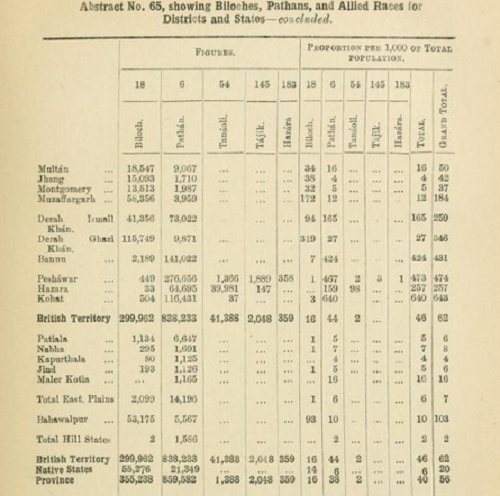Biloch, Pathan and Alhed Races: Introductory and General
This article is an extract from PANJAB CASTES SIR DENZIL CHARLES JELF IBBETSON, K.C. S.I. Being a reprint of the chapter on Lahore : Printed by the Superintendent, Government Printing, Punjab, 1916. |
Introductory and General
Of the Panjab castes and tribes I shall first discuss the Biloch and Pathan who hold all our trans-Indus frontier, and with them two or three races found in tho Province only in small numbers which though not Pathan by origin or indeed in name, have by long associa tion with the Pathans become so closely assimilated to them that it is best to take them here. The figures will be found in Abstract No. 65 below : — Abstract No, 65, showing Biloches, Pathans, and Alhed Races for Districts and States,
These two great nations, the Pathan and Biloch, hold the whole country to the west of the Panjab, the latter lying to the south and the former to the north of a line drawn from the western face of the Sulemans opposite Derah Ghazi Khan almost due west to Quetta. But in the trans-Indus valley and on the Panjab face of the Suleman Range the Biloches have pushed much further north than this,, and the southern border of the Derah Ismail Khan tashil roughly marks the common boundary, while on this side the river the Biloches again stretch somewhat further to the north than on the other. On either bank their common frontier is held by a tribe of mixed affinities, the Khetran being Biloch in Derah Ghazi, Pathan in Derah Ismail, and probably of Jat origin in both ; while in the that the southernmost Pathan tribe is the Baluch, which is probably of Biloch descent.
These two great races present many features of unusual interest. Among both the tribal organisation still siu'vives^ in parts at least; in the most complete integrity, and affords lis examples of one extreme of that series which terminates at the other in the compact village communities of our eastern districts. Moreover the intense tribal feeling of the Biloch and Pathan and the care with which they keep up their genealogies, enable us to point to both nations for undoubted examples of the process by which a race possessed of pride of blood in an extreme degree affiliates to itself sections of other races, gives them a place in its tribal organisation on condition only of subjection to the sitpreme authority, and after a time invents a fiction of common descent by which to account for their presence. There can be little doubt that the process which we know has taken place among the Pathan and Biloch has not been without examples among the other races of the Panjab, and that aboriginal, Mongol, and other elements have in a similar manner been absorbed into the tribal or caste organisation of the Aryan stock.
The Pathans and the Biloches are both foreigners in the Pan jab proper, and have entered its political boundaries within the last few hundred years, though it is not impossible that in doing so the Pathans only re-entered a country which their ancestors had left more than a thousand years ago. Yet their freedom from the irksome and artificial restrictions of caste, and the comparative license which their tribal customs permit them in the matter of intermarriage, have caused their example to produce a wonderful effect upon the neighbouring Indian races ; and it is the proximity of these races, and the force of that example daily set before them by nations living next door, to which, far more than to the mere political supremacy of a Mahomedan dynasty or adoption of the Mahomedan creed,Jatstribute the laxity of caste rules and observances which characterises the people of our Western Plains. The point has already been noticed in section 347.
Some of the social and tribal customs of these people are exceedingly curious. Un fouunately we know but little of them, and what little information I have been able to collect I have not had leisure to record in the following pages. I may however mention two of theu' most striking customs. One is the prevalence of the vesh or periodical distribution of land among the compo nent households of a clan, which we found to be the practice on some parts of the frontier when we annexed the Panjab, while it still exists in full force among both the Biloches and the Pathans of Independent Territory. The second custom is also one common to both nations, though not I beheve to all their tribes. It is the existence of a Levitical clan, often called Mirkhel among the Pathans, who have the exclusive privilege of performing certain priestly functions connected, not with the !Mahomedan religion but with tribal ceremonies, such for instance as the dedication by passing under spears of the fighting men of the tribe when about to go to war.

